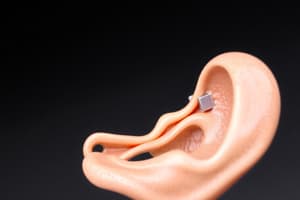Podcast
Questions and Answers
What is the purpose of the peripheral vestibular system?
What is the purpose of the peripheral vestibular system?
- To detect head acceleration
- To stabilize visual images on the fovea of the retina (correct)
- To maintain postural stability
- To respond to changes in head acceleration
What is the alignment of the three semicircular canals in the temporal bone?
What is the alignment of the three semicircular canals in the temporal bone?
- Parallel
- Orthogonal (correct)
- Coplanar
- Intersecting
How is the anterior aspect of the horizontal SCC inclined?
How is the anterior aspect of the horizontal SCC inclined?
- 30° downward from a plane connecting the external auditory canal to the lateral canthus
- 30° upward from a plane connecting the external auditory canal to the lateral canthus (correct)
- 90° from the plane of the horizontal SCC
- 92° from the plane of the horizontal SCC
Flashcards are hidden until you start studying
Study Notes
- The peripheral vestibular system helps stabilize visual images on the fovea of the retina during head movement, and maintains postural stability.
- Each labyrinth contains five neural structures that detect head acceleration: three semicircular canals and two otolith organs.
- The three semicircular canals (SCCs) (horizontal, posterior [inferior], and superior [anterior]) respond to angular acceleration and are orthogonal (at right angles) with respect to one another.
- Alignment of the SCCs in the temporal bone is such that each canal has a contralateral coplanar mate.
- The horizontal canals form a coplanar pair while the posterior and contralateral anterior SCCs form coplanar pairs.
- The anterior aspect of the horizontal SCC is inclined 30° upward from a plane connecting the external auditory canal to the lateral canthus.
- The posterior and anterior SCCs are inclined about 92° and 90°, respectively, from the plane of the horizontal SCC.
The SCCs are tilted by the otolith organs, which are located in the inner ear. These organs respond to changes in head acceleration, and send signals to the SCCs. The SCCs then send signals to the brain, which helps to stabilize visual images on the fovea of the retina.
Studying That Suits You
Use AI to generate personalized quizzes and flashcards to suit your learning preferences.




